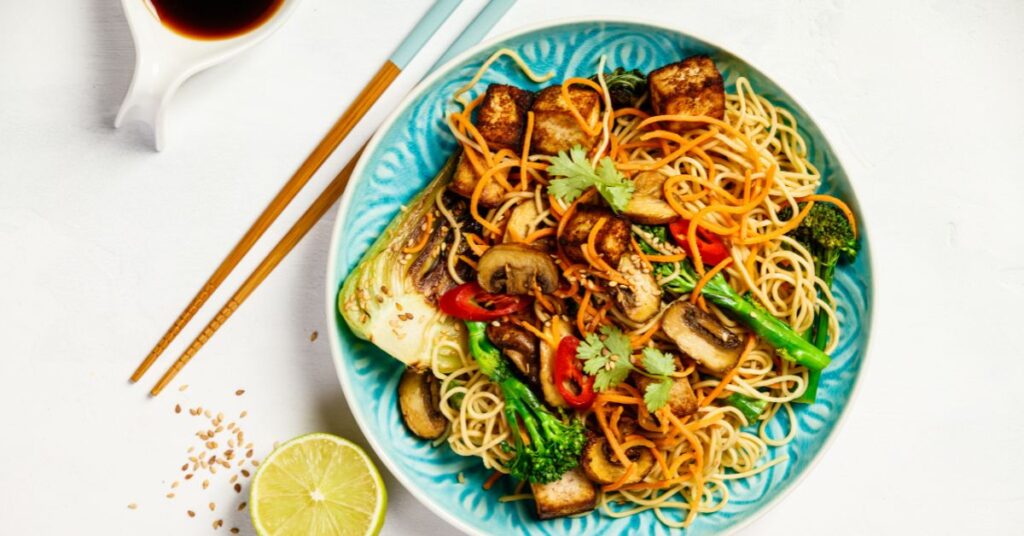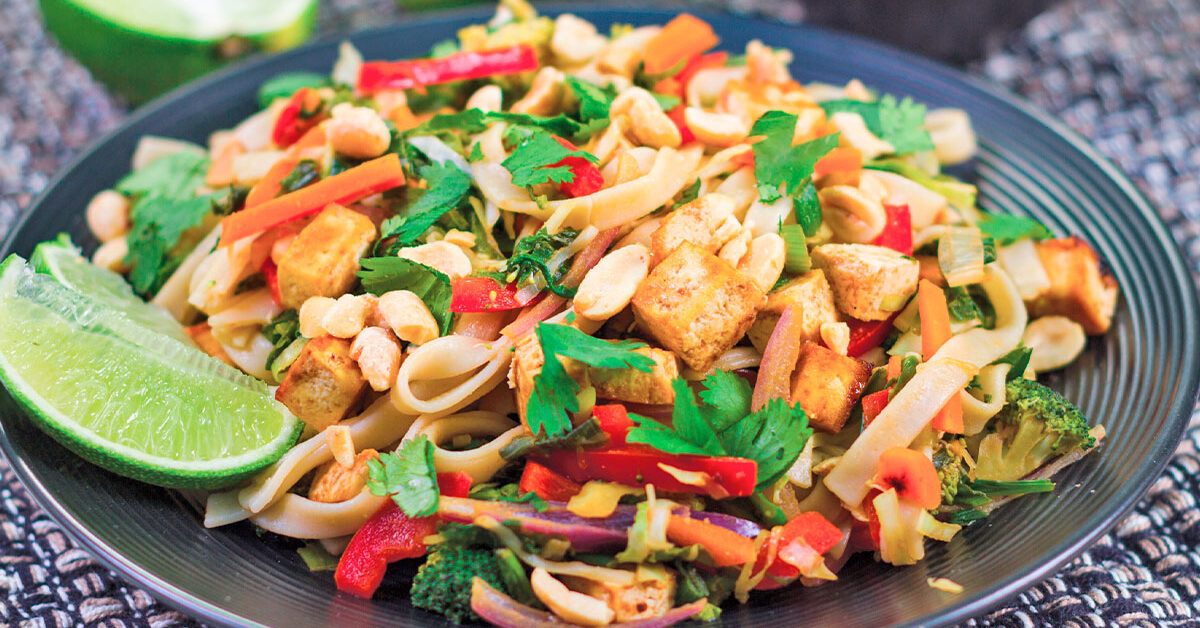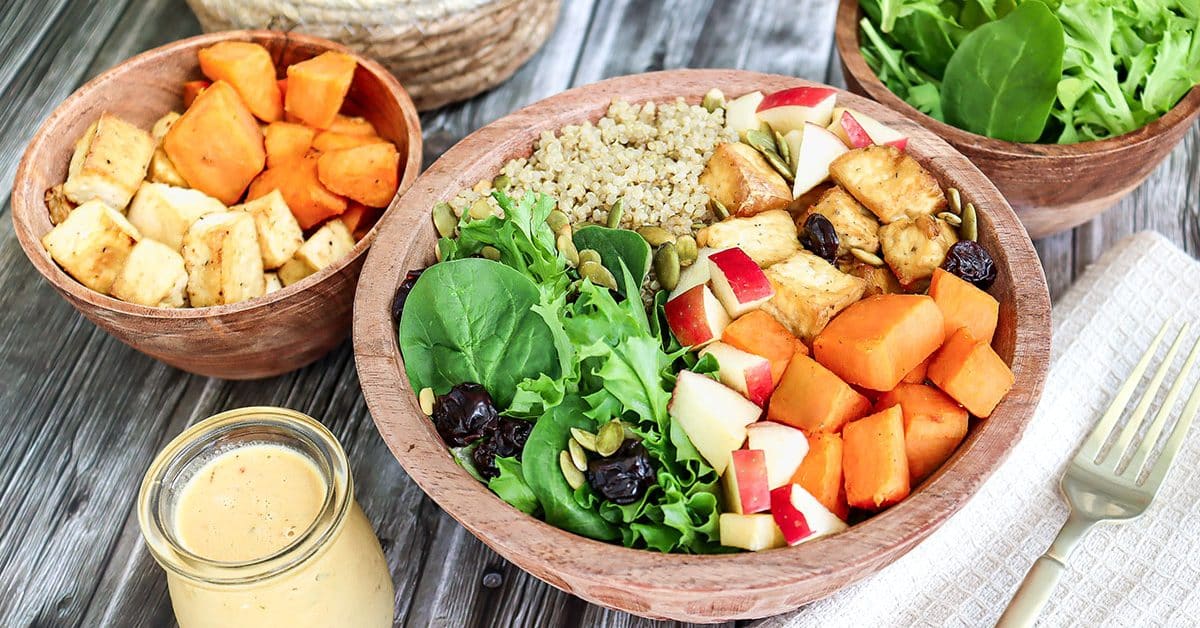

I admit, I may have a stir fry problem. When people ask me what I eat on a whole food, plant-based diet, I have to tell them most days I eat a stir fry. Why? Because they’re delicious, easy, and very versatile. You can make them with seasonal vegetables, any grain or pasta, and whatever seasonings you like—stir fry sauce, tamari, garlic, ginger, etc.
The next question I get asked in plant-based circles is usually, “How do you make a stir fry without oil?” My answer is usually a smile and the response, “It is easier than you think if you follow a few simple rules.” People tend to think that you need some special equipment or secret technique to make a good stir fry. And while I admit that the high-temperature, wok-cooked stir fry you get in a Chinese restaurant has that certain umami (the savory flavor known as the fifth taste), it’s also true that you can achieve great flavor without the oil.
The key is fresh, seasonal ingredients, a good sauce, and a little technique. You don’t even need a wok, and you most certainly don’t need the oil.
Seasonal Ingredients
We already know that seasonal vegetables taste better, are less expensive, and are likely to be fresher and therefore of higher nutritional value. Their flavor comes to life when cooked briefly (stir fry style), and their nutrients are left intact. My favorite stir fry ingredients are whatever I have on hand, which is also the key to making it easy. But if you have favorite stir fry ingredients, make sure to add those to your regular shopping list, so you have everything ready to go for that last minute dinner. I admit that there are days when I use frozen ingredients for my stir fry, especially in the winter when fresh vegetables are more expensive and out of season in my region.
A Good Sauce
There are days when I make a stir fry with nothing more than fresh garlic, ginger, and a little tamari, or even with nothing more than salt and pepper, but I often make a good stir fry sauce to have on hand. My favorite sauce recipe is shown below, and the best part about it is that it keeps for at least a week. When you make your own sauce, you can adjust the ingredients to your taste, leave out the sodium if you prefer, or add a little cayenne pepper for an extra kick.
The Pan
Most people go out and buy a wok and then wonder why they can’t get a good stir fry with it. The truth is, you don’t need a wok. You need a good large skillet with a heavy bottom that will hold heat. Get that pan good and hot and you’ll be able to make stir fry magic happen. The secret to a successful stir fry is to not crowd the pan. Doing so will steam the vegetables instead of stir frying them
The Technique
In most of my cooking classes, I teach how to sauté and stir fry without oil. I‘ve seen a lot of chefs and recipes that start with a little liquid (vegetable broth or water), but I start my vegetables in a dry pan. Most people are surprised that the vegetables don’t burn as soon as they hit the pan, but this actually works well, especially if you start your stir fry with vegetables that have a high water content (onions, carrots, celery, cabbage, bok choy, green beans, mushrooms, etc.). The water in the vegetables acts as a buffer. Once that liquid is released, the vegetables caramelize in the pan, which intensifies their flavor. To see this technique in action, check out a video posted by Naked Food Magazine, or sign up for my cooking class subscription at Foodways.nutritionstudies.org.

Date and Soy Stir Fry Sauce
From The China Study Quick and Easy Cookbook by Del Sroufe
Makes 2 cups
I always have this sauce on hand. With this sauce, some cooked rice or pasta, and a package of frozen vegetables, I can have dinner ready in less than 15 minutes. Even if I have to make this easy sauce, I can have dinner in less than 30 minutes.
¼ cup low-sodium soy sauce or tamari, or to taste
1½ cups salt-free vegetable stock
¼ cup pitted Medjool dates
1½ teaspoons ground ginger
1½ teaspoons granulated garlic
1 tablespoon arrowroot powder
- Combine everything but the arrowroot powder in a saucepan and cook over medium heat for 5 minutes or until the dates are softened.
- Add the cooked mixture to a blender and, with the motor running, add the arrowroot powder.
- Store refrigerated in an airtight container for up to 7 days.
Note
To make this sodium free, replace the soy sauce with an equal amount of vegetable stock

Broccoli, Red Pepper, and Brown Rice Stir Fry
From The China Study Quick and Easy Cookbook by Del Sroufe
Makes 2 servings
I make a batch of Date and Soy Stir Fry Sauce once a week so I can make stir fry whenever I want a quick, healthy meal. Sometimes I use fresh vegetables, and sometimes I pull a bag of veggies from the freezer. Either way, I’ve got a healthy meal full of flavor, without a lot of effort.
1 medium yellow onion, thinly sliced
1 medium red bell pepper, thinly sliced
2 cups frozen broccoli florets
¾ cup Date and Soy Stir-Fry Sauce (see recipe above)
2 cups cooked brown rice
1 cup mung bean sprouts
- Heat a large skillet over high heat. Add the onion and red bell pepper and cook for 2–3 minutes, stirring frequently.
- Add the broccoli and cook for 1 minute, adding water 1–2 tablespoons at a time to keep the vegetables from sticking.
- Add the stir-fry sauce and cooked brown rice, and cook for 2–3 minutes, until the broccoli is heated through. Add the mung bean sprouts and remove from the heat.
Copyright 2025 Center for Nutrition Studies. All rights reserved.
Deepen Your Knowledge With Our
Plant-Based Nutrition
Certificate
Plant-Based Nutrition Certificate
- 23,000+ students
- 100% online, learn at your own pace
- No prerequisites
- Continuing education credits



